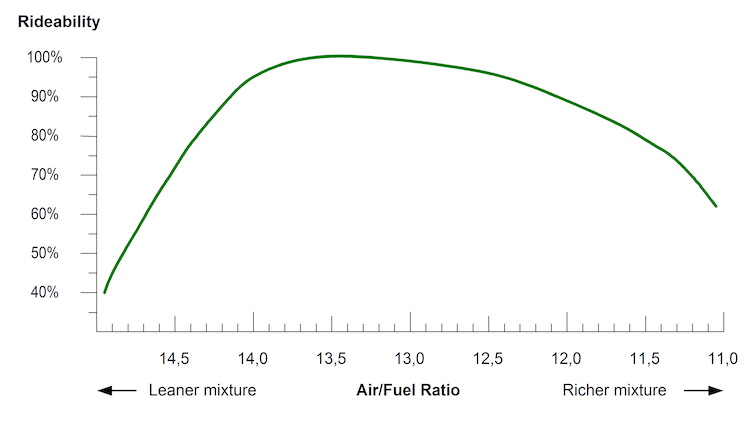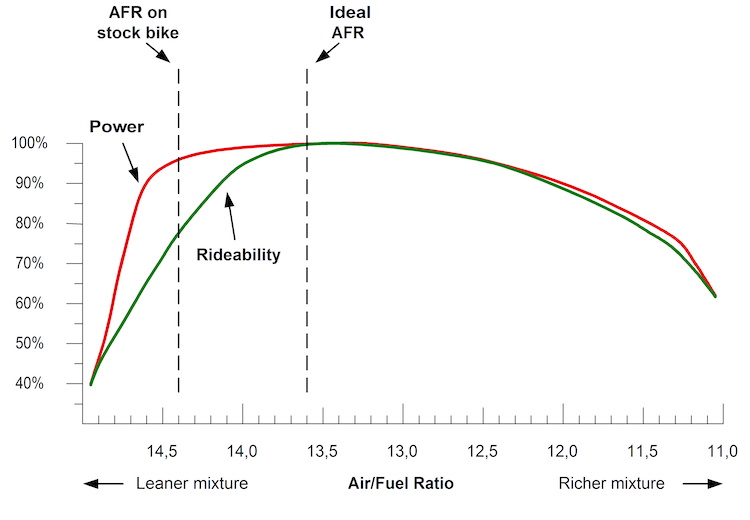As you probably know, your motorcycle engine runs on a mix of air and fuel – or rather fuel evaporated to form a misty mixture that will ignite inside your engine.
The ratio between air and fuel is important because it will have a huge influence on how the engine runs:
• Power – you probably guessed or already knew this
• Rideability – how easy and pleasant the bike is to control
• Engine life – the wrong mixture can destroy your engine or reduce its life dramatically
• Pollution – adding too much fuel will increase pollution.
So getting the air/fuel ratio right is very important.
In theory, the ideal ratio between air and fuel is 14,7:1 in a gasoline driven engine. This is called the stoichiometric mixture
Please note that this ratio is mass based, so we are talking 14,7 kg’s of air to 1 kg of fuel.
As air is not very heavy, we obviously need a lot of air for every liter of fuel.
Air density depends on its temperature, but for this simple calculation, we can consider the density of air to be 1,2 gram per liter. Gasoline have a standard density of 755 grams per liter.
So, one liter of gasoline has the same weight as 629,17 liters of air, and if we want to produce a 14,7:1 mixture, we need 9249 liters of air for every liter of fuel. This is just to give you an idea of how much air is actually sucked into your engine for every liter of fuel that is used.
AFR is commonly used as an abbreviation for ”Air/Fuel Ratio”
“Richer mixture” means a higher gasoline content in the Air/Fuel Mixture, and thereby a LOWER Air/Fuel Ratio figure.
“Leaner mixture” means a lower gasoline content in the Air/Fuel Mixture, and thereby a HIGHER Air/Fuel Ratio figure.
Lambda value is the same as Air/Fuel Ratio, but expressed differently. A Lambda value of 1,0 equals an AFR of 14,7:1, a lambda value of 0,9 equals an AFR of 0,9 x 14,7 = 13,23:1 etc.
To keep the terms consistent in this book, I will refrain from using the Lambda value expression in this book – I just wanted to show the connection between AFR and Lambda.
|
With an AFR of 14,7:1, all the fuel will be burned up inside the engine, and there will be no excess air molecules – if the world was an ideal place.
Unfortunately, there are a number of factors that will make it impossible for the engine to run at 14,7:1:
• The evaporation process where air and fuel is mixed is not 100% perfect
• The ideal combustion chamber shape would be perfect spherical, and the mixture would be ignited from the middle of the sphere. The Combustion chamber in your engine will never be shaped like this.
• Intake and exhaust channels, engine cooling and flywheel weight will have an influence too.
So, the engine needs a mixture slightly richer than the ideal 14,7:1 to run properly – More on the best AFR later.
First we will have a look at the extreme rich and extreme lean mixture to see how this will affect your engine.
Running the engine too rich or too lean will obviously lower the power and the rideability of the engine, but there’s also a big risk to destroy the powerplant.
• Risks with a very rich mixture
• Gasoline is a very good degreaser, and the excess fuel can wash away the oil film on the cylinder wall and make the pistons seize in the cylinder bores.
• Large amount of unburned fuel will clog up the catalytic converter and destroy it.
• Risks with very lean mixture
• Too lean mixture will cause the air/fuel mixture to explode during the engines compression stroke. This way you will not have the desired controlled combustion, but an explosion that will put a lot of extra strain on the moving parts – and destroy the engine over time.
• The excess air in the very lean mixture will increase the combustion temperature a lot, which is very bad for your engine – especially the already thermally stressed exhaust valves will suffer.
 AFR for highest Power: The first question that pops up in AFR discussions is usually which AFR will yield the highest power.
It is not possible to provide a firm answer, because it depends a lot on the engine configuration. The following factors will influence the ideal AFR.
• Combustion chamber and piston head shape
• Cooling method
• Ignition system
• Flywheel weight
Modern, liquid cooled four valve engines will run a bit leaner than an air cooled, two valve engine, and most modern engines are delivering the highest output with an AFR between 13,5:1 and 12,5:1.
The engine will not lose a significant amount of power when you go a bit leaner than 13,5:1 – not until you reach the 14,7:1 mark where the power output will drop of steeply.
Going richer than 12,5:1 will lower the output at a much slower rate, and as you go richer you will feel the engine becoming more and more sluggish and lazy.
The graph below will show the typical relation between Power and AFR in a modern liquid cooled four valve engine.


AFR for best Rideability.
Those of us old enough to remember when motorcycles all had carburetors, can remember how our bikes was much easier and pleasant to ride back then. No low speed surging, no tendency to stall the engine on every take off, and throttle pickup after braking into a corner was smooth and it was easy to apply the right amount of throttle.
It was not because the carburetor was a better solution – but the bikes was allowed to run much richer back then, and that made a hell of a difference to how the bike responded to your input – Rideability.
Therefore, the much leaner AFR in our modern fuel injected motorcycles is to blame for the poor Rideability mentioned above (Low speed surging, stalls, hard and unpleasant throttle action)
The modern emission standards are made for cars, which have a very big, and heavy flywheel and larger internal rotating mass compared to the lighter and nimbler motorcycle engines.
The big flywheels will make the cars accept the lean AFR fairly well, but our motorcycles suffer at lower RPM because the rotating mass is too low to allow smooth running.
As soon as the motorcycle engine reaches a certain RPM level, it will be running OK, but riding the bike in city traffic or hairpin corners is pretty horrible.
The graph below will show the relation between AFR and low speed Rideability. Again, there will be slight differences depending on engine configuration, but the tendency will be the same on all motorcycle engines: When you make the mixture leaner, Rideability suffers long before top end power starts to decrease significantly.

The AFR for optimum Rideability differs to a certain extent from the requirements for the highest power output.
• For mixtures richer than an AFR of 13,6:1, the Power and the Rideability curve will be fairly equal.
• But when you are going leaner than 13,6:1, the Rideability drops of much faster than the Power.

And so what ????
Modern engines are required to run with an AFR very close to 14,4:1, and if you look at the chart below it’s clear that the motorcycle engine will not be lacking top end power, but low speed Rideability is poor.

If you own a car, you know that it is able to run slow without making the ride unpleasant. As mentioned earlier, this is due to the big flywheel in the car engine.
On our motorcycles, we are often forced to run a lower gear than necessary in city traffic to get the RPM’s up (Which will not benefit the environment), and we face a bigger risk of finding ourselves in dangerous situations due to engine stalls and difficult throttle handling.
The motorcycle manufacturers are using all the tricks in the book to make our engines behave just reasonably well, and the following recent inventions are all a result of the research to improve Rideability – not really a search for more top end power.
• Ride by wire throttle (Computer controlled throttle valves)
• Dual ignition (Two spark plugs per cylinder, sometime even individually controlled)
• CNC milled combustion chamber shapes (as opposed to the cheaper casted cylinder head shapes)
• Lambda sensor (O2 sensor) in the exhaust header pipe
• Butterfly valves in the exhaust (Computer operated)
• Variable inlet duct length (Computer operated)
But the motorcycle engine constructors can never make things perfect because the legal AFR requirements are not made for motorcycles but for car engines with higher rotating mass, and the environmental restrictions are getting tighter over the years at more or less at the same pace as new developments are implemented.
The only way to cure the common Rideability problems is to make the engine run slightly richer, and the “sweet spot” AFR in a modern engine seems to be around 13,6:1.
And it’s important to mention that you only need the richer mixture during idle, low RPM running and acceleration and engine braking. As soon as you maintain a steady speed on the open roads, there is no benefit from running the engine richer than stock. Actually this would just be a waste of fuel !
If you expected a graph that would show you which AFR that would give you 20% more top end power, I’ll have to disappoint you. There are virtually no top end power gains to achieve by changing the fuel injection AFR in a modern engine, but if the AFR tweak is done correctly, it can make your bike safer and more pleasant to ride - virtually without changing overall fuel consumption.
 | |





